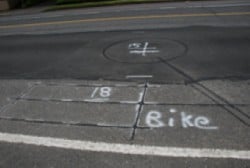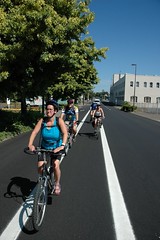
detector installed at 21st and
Sandy has reduced delay for
bicycle traffic by 15%.
(Photo: PBOT)
The City of Portland Bureau of Transportation (PBOT) understands that in order to make bicycling more attractive — and to reach its goal of 25% bike mode share by 2030 — riding a bike must compete better with driving a car. Put another way, bicycling must be seen by a larger number of people as being a convenient option. Beyond building bike-friendly infrastructure, there are other ways to accomplish this sense of convenience. One way to make bicycle travel more efficient is by building a system that causes fewer delays for bicycle traffic.
“This installation will move away from favoring automobiles over other modes by providing advanced detection for both motor vehicles and bicycles, rather than only for automobiles as is currently the case.”
On that note, PBOT has applied for a $250,000 grant from the Oregon Department of Transportation (through their Federal Flexible Fund program) to install 50 advanced inductive loop detectors in bike lanes. Currently, bike loop detectors are installed right at the intersection. These new advanced detectors, which are common on standard vehicle lanes, would be placed well before the intersection. The three main benefits of these new detectors would be:
- They would warn the traffic signal that someone on a bike was coming so the signal could remain green longer, thereby reducing delay;
- by having longer green cycles, the loops would help eliminate what’s known as the “dilemma zone” of trying to decide whether to run a yellow light or stop suddenly;
- and the advance detection loops would also collect valuable data on bicycle volumes at intersections.
According to their grant application (which is titled, Portland’s “Green” Traffic Signals: Reducing Delay on Portland’s Bicycle Network), PBOT wants to, “provide the same service to bikes that it currently provides to vehicles.” The primary motivator for PBOT with this project is to reduce delay experienced by bicycle traffic and to put bike lanes on equal footing with standard lanes. Here’s an excerpt from the grant application:
“… When retrofitting an existing transportation system specifically designed for cars to accommodate non-auto users, increasing connectivity and improving operations for non-auto users while maintaining adequate service for automobiles is challenging. The City of Portland sees that installing advanced loop detection for bicycles is one component of achieving this goal. This installation will move away from favoring automobiles over other modes by providing advanced detection for both motor vehicles and bicycles, rather than only for automobiles as is currently the case.”
PBOT feels that the new advanced bike loops would lead to increased bicycle use because they will increase the convenience of cycling relative to other modes. In the grant application, PBOT notes that at an initial screening of potential locations, they observed a significant reduction in delays — as much as 45 seconds on average — at intersections for bicycle traffic.
In addition to delay reduction, PBOT says advanced detection loops improve safety because they eliminate the dreaded “dilemma zone,” which is that decision point when a light turns yellow and you can’t decide to speed up (and risk running the light/getting hit) or stop suddenly (and risk getting hit from behind). Here’s how the advanced detectors could help with eliminate that:
“By installing advanced detection at intersections, a green indication is held if a bicycle crosses the detector before the signal turns yellow. As a result, the bicycle is allowed to proceed into the intersection with a green signal and the dangerous dilemma zone is ideally eliminated.”
The advanced loop detectors would also be a boon to researchers and planners who would get invaluable information on bike traffic volumes.
PBOT’s request of $250,000 will compete for $21 million in federal transportation funds being awarded by ODOT. Back in August, acting on direction provided to ODOT in the 2009 legislative session to spend more money on non-highway projects, the Oregon Transportation Commission (OTC, which advises ODOT) decided to put aside $21 million from the Surface Transportation Program and award it solely to transit, biking, walking, and transportation demand management (TDM) projects. It’s all part of their movement toward a more “non-highway” future that we reported on back in June.
The OTC will decide on which projects to fund by February 2011. If awarded, PBOT estimates they could complete this project in four to six months.


